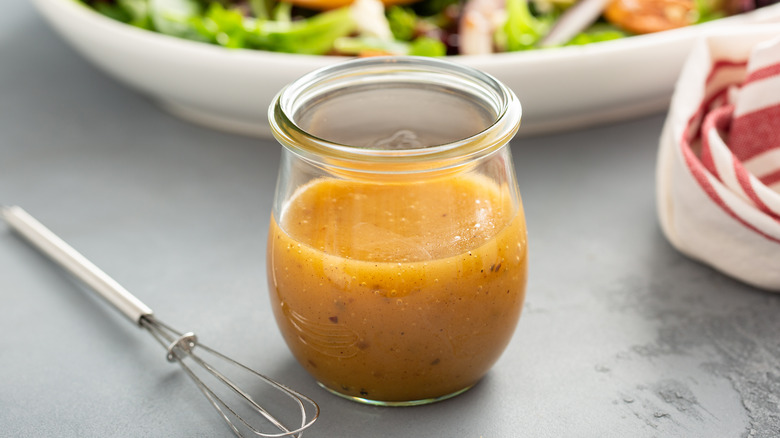How To Properly Store Homemade Salad Dressing
Making salad dressing from scratch is an effortless endeavor with a massive gustatory payoff. Of course, there's also the added bonus of being able to customize recipes however you want. Yet, whether you concoct something out-of-the-box like a pickle juice vinaigrette or whip up a tried-and-true classic like thousand island dressing, following the proper storage protocols is a must to ensure that all of your hard work doesn't go to waste well before it should.
Homemade salad dressings need to be stored correctly in order to prevent quality from being compromised and, more importantly, to minimize the risk of foodborne illness. Since they lack the preservatives found in store-bought bottles, the best policy is to keep all made-from-scratch dressings refrigerated, regardless of their ingredients. Due to their fickle nature, it's also wise to keep them on a cooler (ideally, upper to middle) shelf in the fridge rather than in the warmer door pocket where condiments usually reside.
Additionally, homemade salad dressings also need to be stored in the right container. Generally, the best vessels boast a non-reactive material and an airtight seal to keep chemicals and aromas from seeping into sauces, respectively. Not to mention that a good seal even minimizes spills. That said, nothing beats a glass jar when it comes to storing anything from ranch to raspberry vinaigrette. Just be sure to select the right size as too large of a vessel could actually speed up oxidation. Lastly, don't forget to label your dressings to accurately gauge freshness.
Homemade dressings won't last very long
Despite that made-from-scratch salad dressings have their benefits, a lengthy shelf life is not one of them. In fact, homemade dressings usually won't last for more than three to four days. However, timelines can vary based on ingredients. For example, creamy recipes made with perishable additions like dairy or eggs may spoil faster than vinaigrettes. Yet, even vinaigrettes with punchy levels of acidity may need to be consumed quickly if fresh ingredients like garlic are part of the recipe. In any case, the sooner that you consume homemade dressing, the better.
Made too much dressing? Freeze what's left over. Although any dressing can theoretically be frozen, vinaigrettes tend to be at a lesser risk of ruin when frozen and thawed compared to their creamy and dairy-based counterparts, as fatty bases (think mayo, Greek yogurt, cream, etc.) can quickly separate. You could attempt to thaw to a semi-solid state then whip back to normalcy, though that's not a guaranteed fix. Nevertheless, frozen dressing in an airtight container can keep for months. But, even then, nothing lasts forever.
In the absence of expiration dates, there are signs of spoilage to look out for when determining whether homemade dressing is still okay to consume. While it may be normal in vinaigrettes, separation in creamy dressings can indicate the sauce has passed its prime. Otherwise, changes in color or the presence of mold coupled with sour or rancid aromas signal a dressing should be tossed and a new batch should be made.

